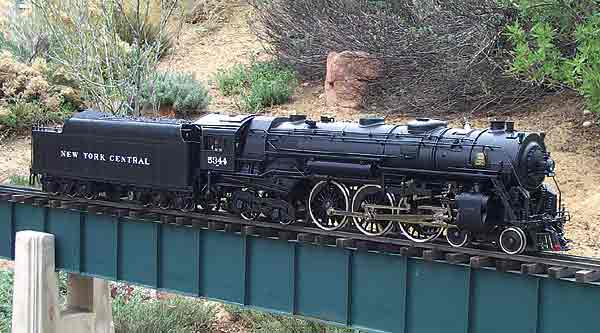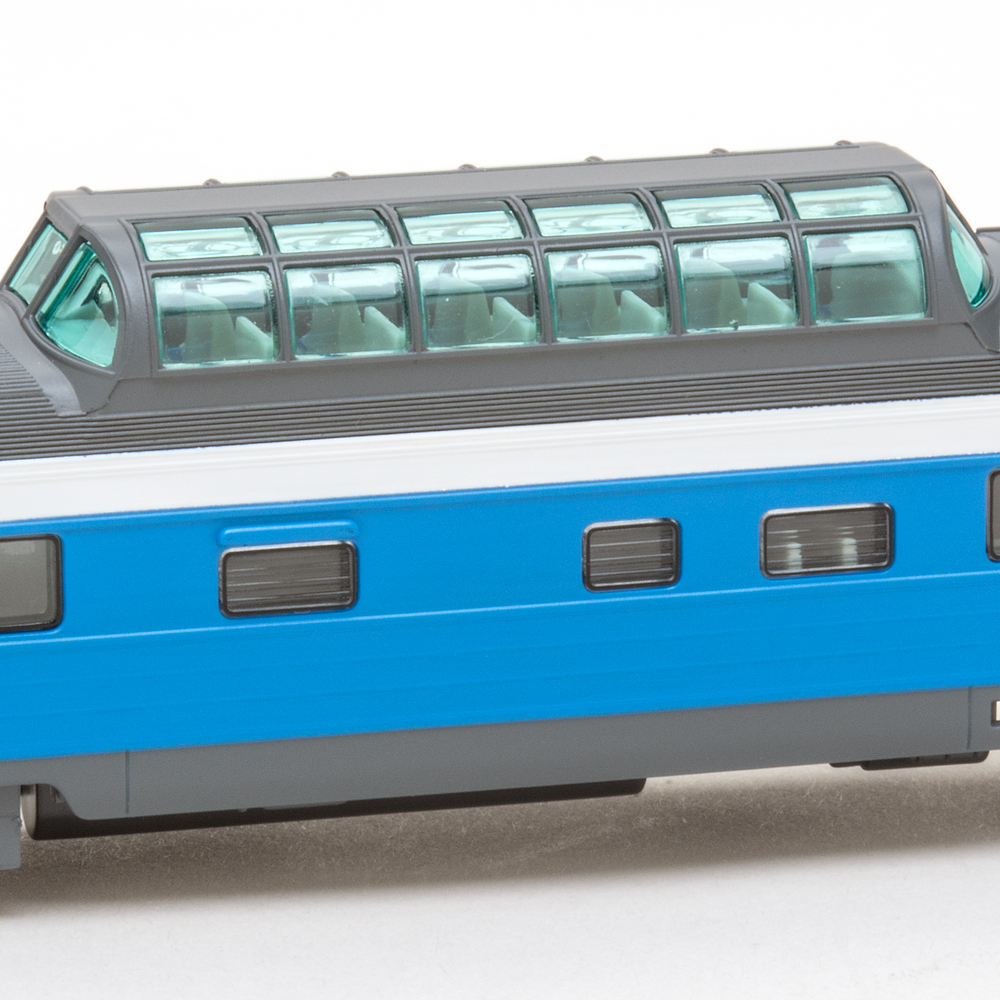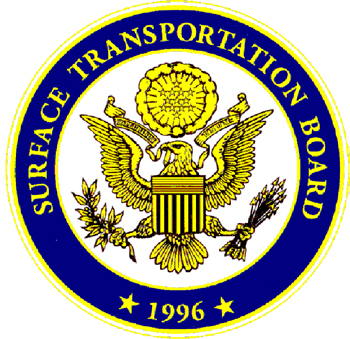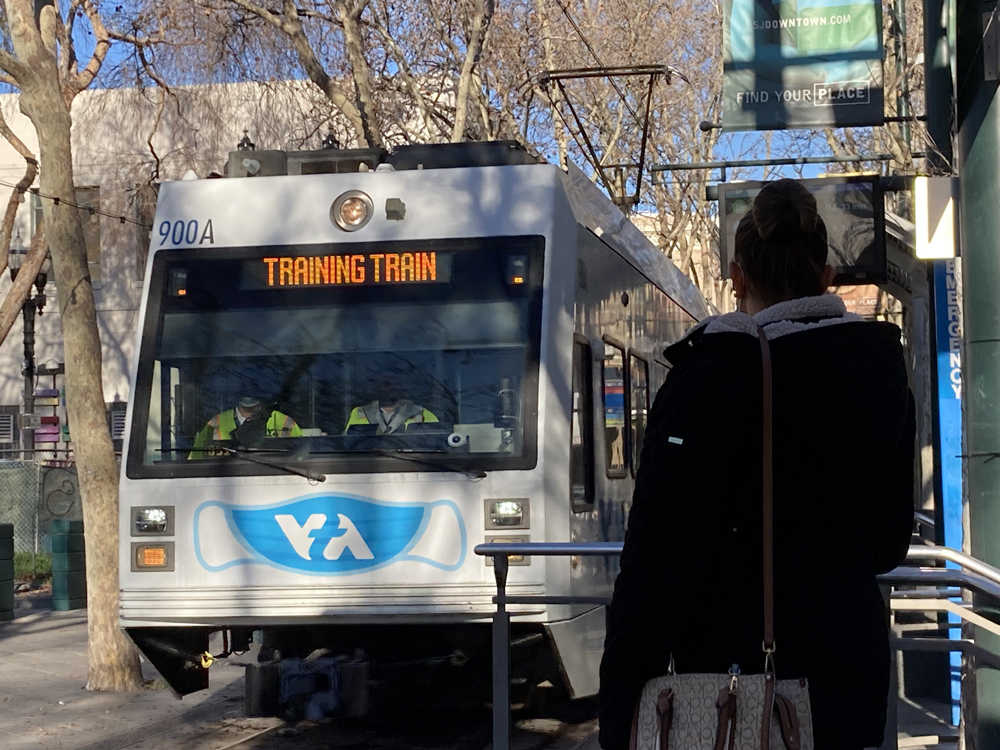USA Trains
PO Box 100
Malden MA 02148
Price: $2,299.95 w/o sound; $2,699.95 with Phoenix sound system installed
Web site: www.usatrains.com
All-metal model of New York Central’s J1e Hudson; die-cast boiler, cab, tender shell, and detail parts; smoke unit synchronized to axle rotation (four puffs per revolution); working headlight, cab light, and marker lights on locomotive and tender; working, metal, body-mounted coupler on tender; dummy coupler on pilot; roller-bearing drive axles; engine is “sound ready” for Phoenix sound system; lighted firebox and ashpan; front drivers powered by motor in boiler, others driven by metal side rods; articulated siderods; opening cab windows, firebox door, smokebox door, and roof vents; operating marker lights and backup light on tender; sprung drivers; sprung tender trucks; control switches for motor, lights, smoke, sound on/off, and sound volume; wooden display/carrying case included. Weight: locomotive, 24 lbs.; tender, 12 lbs. Dimensions: Length overall, 40v”; width, 41/8″; height, 6˜”. In 1:29 scale, this works out to 97’10” x 10’3″ x 15’1″. Tractive effort: 72 oz. at full slip, or the equivalent of around 58 standard freight cars
Pros: Exceptionally high level of detail; high fidelity to prototype; excellent satin-black finish and graphics; lateral play in second driven axle to help negotiate tighter curves; front dummy coupler drops into pilot, as per the prototype; correct four puffs from the smoke unit per driver revolution; 10 power pickup points; no electrical pickup skates; attractive wheel profile; near-prototypical coupling distance between locomotive and tender when close coupled
Cons: Front dummy coupler doesn’t mate with others; poorly modeled figures in cab; shiny wheel rims detract from appearance; difficult to close-couple engine and tender in upright position
USA Trains’ locomotive is available in a variety of road names, including NYC (two engine numbers available), AT&SF, UP, SP, Rio Grande, and Toronto, Hamilton & Buffalo. Each road name is available with or without a Phoenix sound system installed. Our review sample is the New York Central Nº 5344, without sound.
The engine comes packed in a hardwood display/carrying case with hinged doors and carrying handles at the ends. Locomotive and tender are bolted to wooden trays in the box and an allen wrench is supplied to free them. Separate unpacking instructions are supplied. Read them. All major and lots of the minor components are diecast metal, giving the engine both real and visual mass. The locomotive and tender together weigh 36 pounds. Once the engine is out of the box you can begin to look around. The detail level is very high indeed. Rivet detail is sharp and to scale. Nearly all piping is included and almost all other detail is applied as separate parts. Very little is cast in. The correct Baker valve gear is modeled and all valve-gear parts are blackened, though a little shiny. The backhead is fully fitted out and detail looks complete. Unfortunately, there are two strange-looking characters driving the engine. Control switches for electricals and sound are conveniently concealed behind panels on the boiler sides on in front of the cab. If you didn’t know to look, you’d never know they were there.
The tender is equally well detailed, with a water scoop, truck chains, opening water hatch, fully sprung trucks, and even an auger at the bottom of the coal hopper. Underbody detail is also well rendered. The coal load is a separate, easily removable piece.
I was particularly pleased to see the closer-to-scale wheel profiles. The deep flanges that often mar the appearance of scale trains are gone and the wheels look very good. The locomotive’s weight, combined with the way the engine and tender are sprung, should help get it through even marginal track. The only jarring note is the shiny stainless-steel wheel rims, which could be touched up with a bit of black paint. There is plenty of daylight under the boiler and even in the frames behind the first driver.
Engine and tender are coupled with a two-hole drawbar on the locomotive. Use the rear hole for sharper curves and the near one for close coupling. The locomotive will negotiate #1500 curves, but looks pretty awful doing it. An engine of this size looks much more at home on 10′-radius or larger curves. I found it difficult to couple the tender to the front hole when the engine was upright, as the drawbar fouled the tender’s leading truck. Laying the engine on its side made the job easy, but then transporting the locomotive and tender together to the track became problematic-almost a job for two people unless you can achieve the coupling next to the track, then just roll the engine up onto it.
On the prototype, the front coupler drops down into the pilot when not in use; so it does on the model. However, when the coupler is up, it will not mate with the oversize USA Trains couplers, as it is more prototypical in size. A working, metal coupler is body-mounted to the rear of the tender.
Power from the track is taken at 10 points-all drivers and a pair of wheels on each tender truck. The motor is in the boiler shell and drives a massive metal gear on the first axle. The second and third axles are driven by the metal side rods, which are equipped with bronze bushings. A special wrench is supplied to remove the drive pins, should that be necessary. The speaker for the sound system is to be mounted in the firebox, not in the tender.
Performance on the track is excellent. The engine will just creep along at around 2V. At 24V, with wheels slipping, the engine draws just over three amps. With 72 ounces of pull, the locomotive should haul nearly 60 standard freight cars, and this is without traction tires. Top speed at 24V is acceptable, though probably nowhere near the prototype’s 90+ mph. The smoke unit puts out four puffs of smoke per driver revolution, though this is only noticeable at slow speeds. The engine runs quietly, even at top speed, so motor noise should not interfere with a sound system, should you opt for one.
This is a fine, accurate, well detailed, robust model that absolutely captures the soul of the prototype. It will look splendid heading up a long freight drag or at the point of a train of USA Trains’ upcoming full-length passenger cars.














